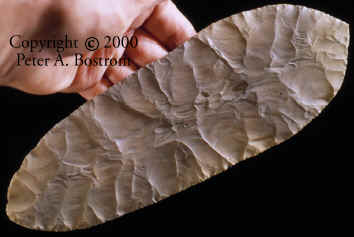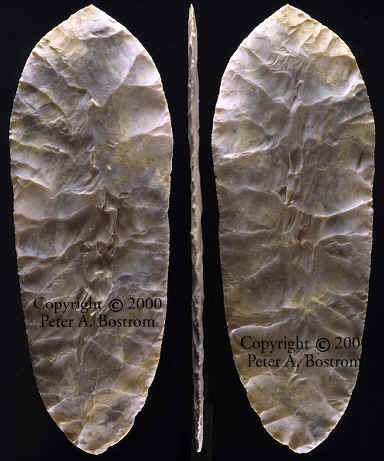|
2001
JANUARY
THE
EXTRAORDINARY
SWEETWATER
BIFACE
NOLAN
COUNTY, TEXAS
What is a biface
anyway? The term is used to describe flaked stone artifacts that have been
flaked or chipped on both sides. Unifacial, is another term that is used
to describe artifacts that are flaked only on one side with one large
removal flake on the other. Biface is the descriptive word that is used
when the item being described is not any one of a multitude of named
artifact types like Table Rock point, Harahey Knife, Adz or whatever. It's
often used to describe Old World Paleolithic Hand Axes and Chopper
Cleavers such as bifacial Choppers, etc. The term has been used to describe the
Sweetwater Biface because this artifact is not a named type or at least
has not been definitely identified as a type.
|
|
SWEETWATER
BIFACE
NOLAN CO., TEXAS
CHARLEY SHEWEY
COLL.
This extraordinary biface was found by Mr. Roland Kamer of Sweetwater,
Texas while hunting rattlesnakes for the 1986 Sweetwater Rattlesnake
Roundup. He found it on the surface of the ground in a gully. Other
bifaces similar to this one have been found in this general area of the
Southern Plains, although most are broken.
It's believed that this biface could be related to the
Caddoan Culture and Harahey Knives. If so, it could date to somewhere
around A.D. 1300 to A.D. 1500. Newly made Harahey Knives have the same
ovoid bipointed shape as this examples does. By this definition the
Sweetwater Biface
was made to be used as a knife for butchering game. It would have been
reduced in size by resharpening as it became dull or damaged from use.
The control of the master craftsman who made this biface is
amazing. Modern flintknappers have made bifaces this thin but not nearly
so wide. The wider the biface is the harder it is to strike off large
thinning flakes across the midline to thin it down. The Sweetwater Biface
measures 9 7/16 inches long, 3 3/8 inches wide and 3/16 of an inch
thick. Thickness ranges down to 1/16 inch near the edge and 5/32 inch in
the center. Most of the large percussion thinning flake scars extend 1 3/4 to 2 3/16
inches long.
This artifact is so exceptionally well made that it is
possible it may have been intended for ceremonial use such as being placed
with a burial as grave offerings. Unbroken and unresharpened bifaces of
this type are very rare so few have survived for comparison studies. The
Sweetwater Biface is a lucky find that survives as a tribute to the master
craftsman who made it so long ago.
|

A
CAST OF THIS POINT IS AVAILABLE (CLICK HERE)
SWEETWATER BIFACE
NOLAN COUNTY,
TEXAS
CHARLEY
SHEWEY COLLECTION
This is one of the most skillfully percussion flaked bifaces ever found in
North America
"CLICK
ON PICTURE FOR LARGER IMAGE"

SWEETWATER BIFACE
NOLAN COUNTY, TEXAS
CHARLEY
SHEWEY COLLECTION
This picture shows a triple exposure of the famous Sweetwater Biface. It
is so wide and thin no one, that we know of, has been able to duplicate it
in modern times. It measures 9 7/16 inches long, 3 3/8 inches wide and
3/16 of an inch thick.
CLICK ON
PICTURE FOR LARGER IMAGE 
BASAL NOTCHED BIFACE
BELL COUNTY, TEXAS
GLEN BEAUCHAMP COLLECTION
This biface was broken in the center by pressure flaking it to thin plus
the interaction of a natural flaw in the stone.
|


